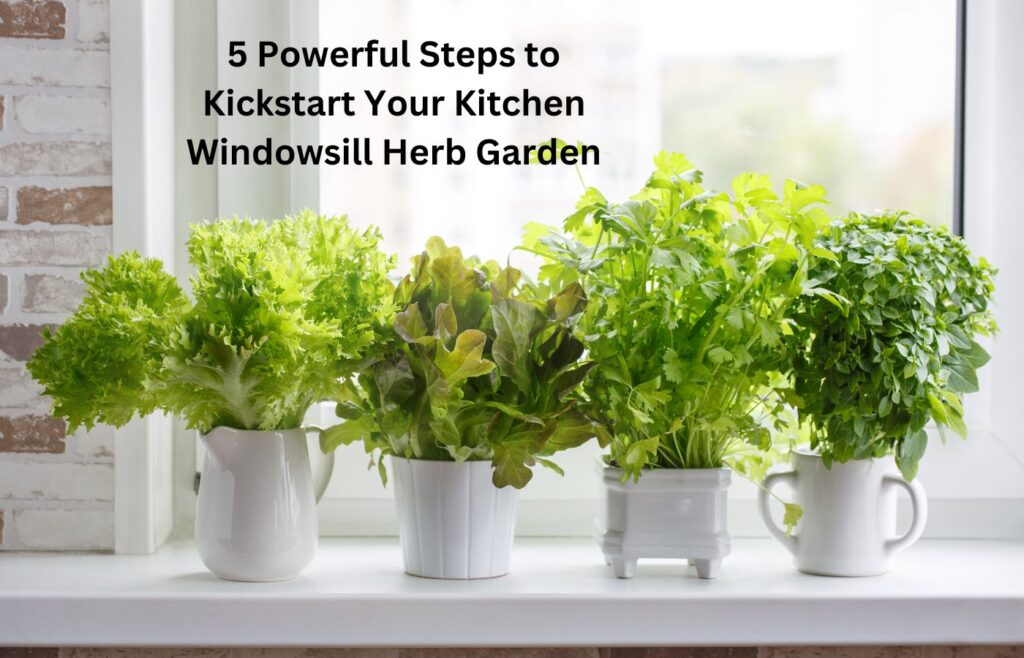Introduction – Kitchen Windowsill Herb Garden
Think about entering your kitchen and being welcomed by a vibrant assortment of aromatic herbs, flourishing in the comforting presence of sunlight filtering through your windowsill. Planting a herb lawn on this tranquil area of one’s property is not merely a fantastical illusion but rather a verifiable reality poised to disseminate. In a fast-paced and fashionable global society, where convenience often precedes social interaction, there is a deep sense of satisfaction in cultivating a collection of culinary delights within one’s own home.
The notion of a kitchen windowsill herb garden encompasses a seamless integration of functionality and visual appeal, offering culinary recommendations and visual allure. The ability of nature to bring the outside into and enhance ordinary activities with a touch of greenery and vibrancy is a tribute to its transforming potential. Whether you are an experienced chef seeking to enhance your dishes with vibrant, locally sourced flavors or a novice gardener desiring to cultivate a more profound connection to the natural world, the kitchen windowsill herb garden presents an enticing opportunity and potential.
However, beyond the allure of luxury and grandeur, there is a deeper significance—a bond with our literal and symbolic origins. Historically, herbs have been highly respected for their therapeutic properties, culinary applications, and symbolic significance. Throughout history, these little plant species have become integral to the fabric of human existence, enhancing our lives in boundless ways.
In contemporary mass production and commercial agriculture, cultivating herbs for one’s kitchen windowsill herb garden is a revolutionary endeavor to regain authority over our dietary choices and methods of sustenance. This is a declaration of autonomy from the limitations of grocery store aisles and a reversion to the uncomplicated joys of nurturing living organisms with our hands.
This tutorial will provide you with a detailed explanation of five practical methods to initiate your kitchen windowsill herb garden. These processes include planning, planting, caring for, and harvesting your cherished herbs. Collectively, we will commence a journey of exploration and contentment, relishing the pleasures of horticulture and the abundance of nature’s produce. Prepare yourself by rolling up your sleeves, gathering your pots and soil, and embarking on the captivating endeavor of establishing a herb lawn on your kitchen windowsill herb garden.
Step 1: Planning Your Herb Garden – Kitchen Windowsill Herb Garden
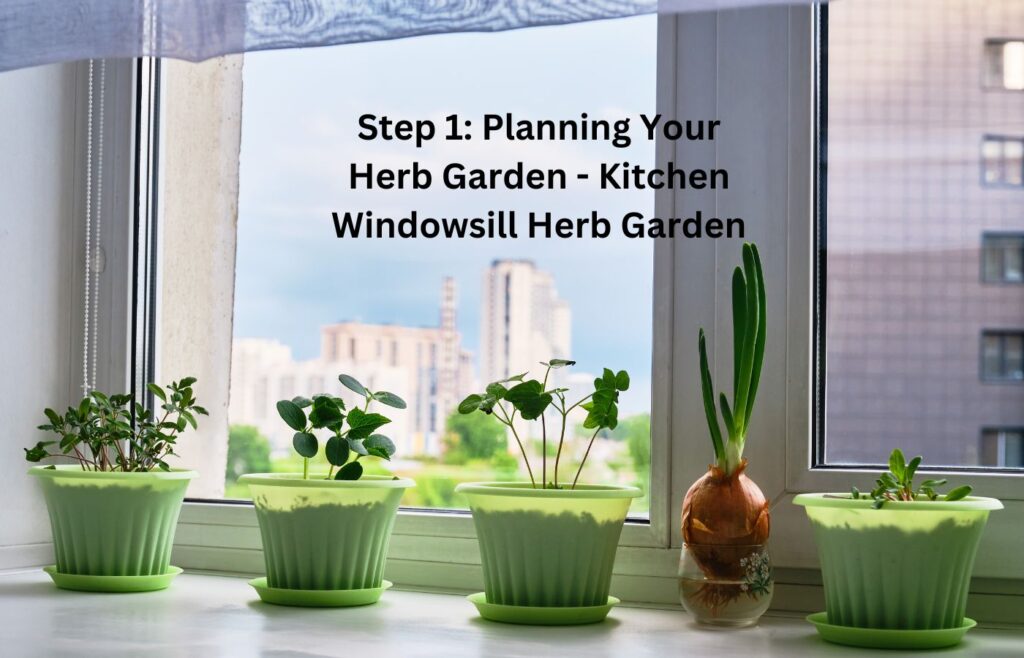
Before entering into the area of kitchen windowsill herb garden, it is imperative to commence with a meticulously devised plan. Establishing a well-designed herb lawn is crucial for achieving favorable outcomes, as it allows for optimal utilization of the available space, sunshine exposure, and selection of herbs.
Assess Your Space:
Commence by conducting a comparative analysis of your kitchen windowsill for the kitchen windowsill herb garden to determine its alignment and the quantity of natural light it receives for the day. Choose a location that provides sufficient natural light for herbal plants, as most herbs flourish in a minimum of 6 hours of daylight. It is important to carefully consider any potential obstacles or constraints that could impact the positioning of your kitchen windowsill herb garden, such as curtains, blinds, or adjacent furniture.
Consider Your Herb Selection:
It is important to carefully consider the selection of herbs for cultivation in a kitchen windowsill herb garden. Consider your culinary options, cooking practices, and preferred dish varieties. Commonly cultivated indoor herbs encompass basil, thyme, mint, parsley, chives, and rosemary, among several others. Select herbs that are suitable for indoor environments that can flourish inside the confined space of a windowsill lawn.
Plan Your Layout:
After selecting your herbs, carefully establish the arrangement of your kitchen windowsill herb garden. One should consider the bins’ dimensions and configuration, as well as the maximum number of herbs that can be accommodated on the windowsill without causing excessive congestion. Optimize the arrangement of your herb pots to maximize exposure to sunshine and air circulation, ensuring that each plant has plenty of space to grow and flourish.
Research Care Requirements:
Before proceeding with the planting of your herbs, it is advisable to undertake a comprehensive analysis of their care requirements, encompassing aspects like watering, fertilizing, and pruning. It is imperative to acquaint oneself with the distinct requirements of each herb, since certain plants may necessitate greater attention than others. It is advisable to establish a care agenda or checklist as a means of maintaining organization and guaranteeing optimal care for herbs, hence facilitating their flourishing.
By meticulously designing your kitchen windowsill herb garden, you will position yourself for success and optimize your chances of cultivating nutritious and flourishing herbs, allowing you to embellish your culinary masterpieces for an extended period. Grab a pen and paper, unleash your imagination, and commence the process of designing your herb garden masterpiece!
Step 2: Selecting the Right Containers – Kitchen Windowsill Herb Garden
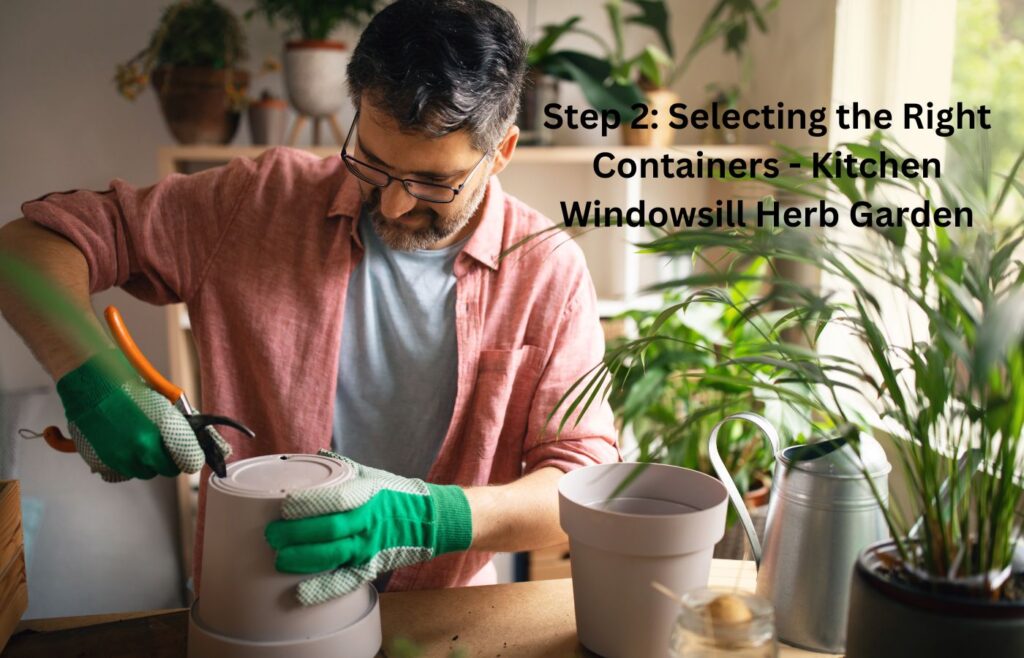
After deciding on establishing a kitchen windowsill herb garden, the subsequent task involves carefully selecting appropriate containers to accommodate the cherished herbs. Choosing a suitable receptacle is crucial for creating the optimal conditions for cultivating your herbs and guaranteeing their well-being and potency.
Size and Space Considerations:
When making decisions regarding packing containers for kitchen windowsill herb garden, it is important to consider the dimensions and form of the kitchen windowsill and the available space for the growth of herbs. Choose containers easily maintained on your windowsill without excessive crowding or impeding air circulation. Smaller pots or planters are optimal for individual herbs, while larger containers can handle multiple herbs or larger varieties.
Ensure Adequate Drainage:
Ensuring sufficient drainage to prevent wet soil and root rot is imperative. Therefore, selecting boxes with suitable drainage holes on the rear side is crucial. If your bins lack drainage holes, drilling or punching holes to provide adequate drainage is important. Furthermore, applying a layer of gravel or tiny stones at the base of each field is recommended to facilitate drainage and mitigate the risk of soil compaction.
Opt for Lightweight and Portable Options:
Given that your herb garden may be situated on your kitchen windowsill, selecting packing containers that are low in weight and facilitate effortless transportation is vital. It is advisable to utilize plastic, ceramic, or terra cotta pots, as they are lightweight and portable while still providing a satisfactory equilibrium for your herbs. Refrain from using unwieldy or unwieldy containers that may pose difficulties in handling or transporting.
Get Creative with Design:
Although the utility is crucial, it is advisable to incorporate humor and ingenuity into the arrangement of your herb containers. To add a distinctive and customized element, contemplate utilizing decorative pots, planters, or reused receptacles like mason jars or tin cans. Unleash your creativity and select containers that mirror your style and enhance your kitchen decoration.
By carefully selecting the appropriate containers for your kitchen windowsill herb garden, you will establish a delightful and practical space for your herbs to flourish. Thorough evaluation of length, drainage, portability, and design is crucial in establishing a favorable and valuable herb farming endeavor. Take proactive measures, explore your options, and select the appropriate packaging containers to actualize your herb garden!
Step 3: Preparing the Soil and Planting Your Herbs – Kitchen Windowsill Herb Garden
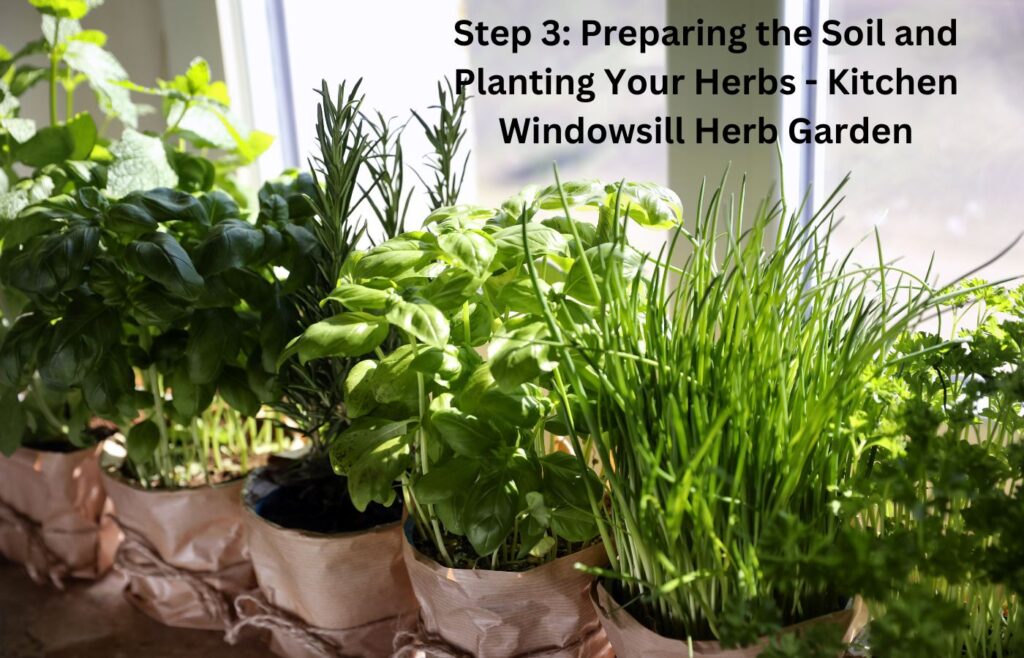
After carefully choosing the appropriate packing containers for the kitchen windowsill herb garden, the subsequent step involves assembling the soil and cultivating the herbs. Ensuring appropriate soil preparation is vital to furnish herbs with the necessary vitamins and optimal growing conditions for optimal growth and development.
Choose a High-Quality Potting Mix:
Commence the process of choosing an optimal potting mix designed for cultivating indoor herbs or field gardening. Refrain from utilizing grass soil, as it may harbor pests, diseases, or weed seeds that could have detrimental effects on your herbs. I am seeking a potting blend that is both lightweight and well-draining, capable of retaining moisture while also allowing for the unrestricted drainage of excess water.
Fill Your Containers:
Place potting mix into each box, ensuring to maintain a few inches of space on the top for watering. Precisely compact the soil to eliminate any voids and establish a level surface suitable for planting. Ensure that the soil is not excessively compacted, since this will impede root development and drainage.
Choose Healthy Herb Plants:
Choose robust herb blooms from a reputable nursery or garden center. Search for vegetation exhibiting vivid green foliage, sturdy stems, and absence of any indications of disease or infestation by pests. Avoid flowers that exhibit signs of wilting, yellowing, or legginess, as they might pose a nuisance or pose a risk. If feasible, it is advisable to select tender flowers that have not yet surpassed the size of their pots, as this will expedite their establishment in their new habitats.
Plant Your Herbs:
The herbs should be carefully extracted from their nursery pots and the roots should be gently loosened to promote outward growth. In each field, create a small cavity and carefully position the herb plant therein, ensuring that the highest point of the root ball is parallel to the surface of the soil. Fill the backfill with a supplementary potting mix and apply gentle pressure to ensure the plant is securely positioned. Water is ideal for facilitating soil settling and promoting root hydration.
Label Your Containers:
Assign labels to each box indicating the name of the herb-planted interior to effectively monitor your herbs and their specific care needs. To visualize each herb, one may employ water-resistant plant markers, diminutive stakes, or ornamental labels. This will aid in the retention of herb identification and guarantee that they receive the appropriate attention and nurturing necessary for their flourishing.
By diligently preparing the soil and meticulously planting the herbs, one can optimize their initial growth and development in the kitchen windowsill herb lawn. By utilizing a potting blend that is abundant in nutrients, cultivating herb plants that promote health, and ensuring appropriate labeling, one may establish a flourishing herb garden that provides not only sensory pleasure but also enhances culinary endeavors over an extended period. Begin by rolling up your sleeves, engaging in soil excavation, and allowing the process of planting to commence.
Step 4: Providing Care and Maintenance – Kitchen Windowsill Herb Garden
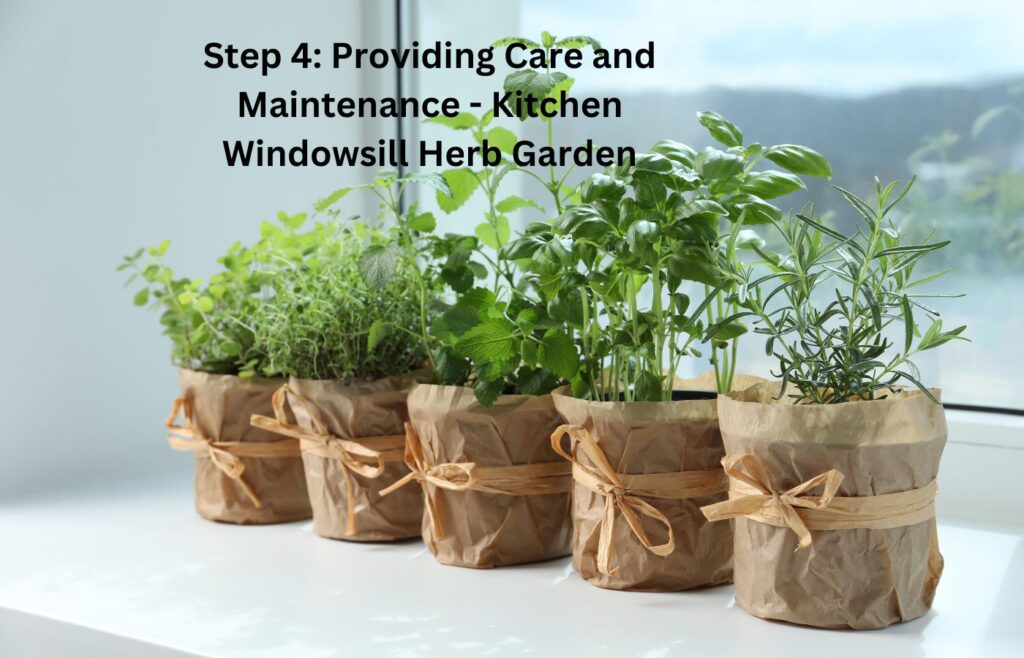
After planting a kitchen windowsill herb garden, it is imperative to provide regular care and preservation to promote the growth and flourishing of the herbs. Ensuring appropriate maintenance and attention will facilitate the flourishing of your herbs, resulting in abundant foliage and a plentiful yield of fresh, tasty leaves suitable for your culinary endeavors.
Watering:
It is imperative to consistently irrigate your herbs, ensuring that the soil maintains a moderate level of moisture without excessive saturation. The frequency of watering will be contingent upon various factors, such as the size of the containers, the type of herbs being cultivated, and the ambient conditions within the household. Frequent assessment of soil moisture levels can be conducted by inserting one’s finger into the soil. If the soil appears dry upon contact, it is advisable to apply water. Cease overwatering, as it might result in root decay and other complications.
Sunlight:
By positioning the herb pots in a sunlit area on the kitchen windowsill, they will be exposed to a minimum of six hours of sunshine aligned with the diurnal cycle. It is advisable to occasionally rotate your bins to ensure uniform exposure to daylight and promote balanced growth. If the windowsill does not receive an adequate amount of natural light, it is advisable to consider supplementing it with a well-lit light source to ensure that the herbs receive the necessary light to flourish.
Fertilizing:
It is recommended to apply a well-balanced liquid fertilizer to your herbs at regular intervals of 4-6 weeks during the growth phase to provide them with essential nutrients necessary for robust growth. When selecting a fertilizer for indoor herbs or box gardening, it is important to adhere to the instructions provided by the maker regarding its use. To prevent nutritional imbalances and harm to your herbs, it is advisable to refrain from excessive fertilization.
Pruning and Harvesting:
The practice of trimming and harvesting is crucial for maintaining the vitality and vitality of one’s herbaceous plants. Detach or trim small portions of leaves to stimulate the growth of hairy plants and prevent your herbs from getting untidy. Harvest herbs during the morning hours when their flavor and aroma peak, employing sharp scissors or pruning shears to facilitate effortless incisions.
Pest and Disease Control:
It is vital to remain vigilant for prevalent pests, such as aphids, spider mites, and whiteflies, alongside indications of disarray, such as the presence of yellowing foliage or stagnant soil. If one observes the presence of pests or indications of illness, it is advisable to promptly initiate measures to mitigate the issue by employing organic pest management techniques or utilizing plant-safe fungicides.
By implementing proper maintenance and care practices for your kitchen windowsill herb garden, you can provide an environment conducive to the growth and prosperity of your herbs. This will ensure a continuous supply of fresh and aromatic leaves for your culinary endeavors. By implementing appropriate irrigation, exposure to sunlight, fertilization, pruning, and insect control measures, individuals can expect a plentiful yield of locally cultivated herbs throughout the year. Begin by rolling up your sleeves, preparing your green thumbs, and allowing the process of care and maintenance to commence.
Step 5: Harvesting and Enjoying Your Herbs – Kitchen Windowsill Herb Garden

As the kitchen windowsill herb lawn undergoes growth and development, it will eventually be time to enjoy the benefits of your diligent efforts and fully appreciate the fruits of your endeavors. Preserving your herbs at their optimal level of freshness guarantees the highest level of flavor and fragrance, elevating your culinary creations and elevating your meals to unprecedented levels.
Timing Your Harvest:
Collect your herbs when they are at their optimal flavor and aroma, usually in the morning after the dew has evaporated but before the sun reaches its highest point. Refrain from collecting herbs during the peak of the day, as this might lead to their wilting and depletion of essential oils. It is advisable to regularly harvest herbs to stimulate new growth and maintain a consistent supply of fresh leaves for culinary purposes.
Harvesting Techniques:
Utilize precise scissors or pruning shears to gather your herbs, creating precise incisions immediately above a firm and firm set of leaves or nodes. Refrain from harvesting larger portions of the plant simultaneously, as this may exert pressure on the plant and impede its growth. It is recommended to prioritize the harvesting of the outer leaves and stems while allowing the inner boom to continue its growth.
Storing Fresh Herbs:
Upon picking your herbs, delicately rinse them under water devoid of blood to eliminate any particulate matter or particles. Remove any excess moisture and employ a soft towel to gently dry the items. Sparkling herbs can be preserved for an extended period by storing them in the refrigerator, either wrapped in moist paper towels or placed in hermetic bins. Alternatively, you can desiccate, cryopreserve, or utilize them to imbue oils or vinegar for subsequent utilization.
Using Fresh Herbs in Cooking:
The Utilisation of Fresh Herbs in Culinary Practices: The incorporation of fresh herbs significantly enhances the flavor profile and aromatic intricacy of a wide array of culinary preparations, encompassing soups, salads, sauces, and marinades. Conduct trials with certain combinations of herbs and culinary techniques to showcase the distinctive flavors and fragrances of your locally cultivated herbs. Whether one is incorporating a small quantity of basil into their tomato sauce or adorning their grilled fish with a delicate sprinkling of glittering dill, it is advisable to follow one’s imagination and derive pleasure from the delectable results.
Sharing the Bounty:
Distribute the abundance of your herb lawn on your kitchen windowsill herb garden to your friends and family by presenting them with freshly collected herbs or homemade chocolates laced with herbs. Disseminate the delight of locally grown herbs and motivate others to embark on their herb gardening endeavors, fostering relationships and networking through the uncomplicated satisfaction of sharing nature’s abundance.
You will encounter the authentic essence of kitchen windowsill herb gardening through meticulous cultivation and appreciation – a manifestation of nature’s bountiful resources and the gratification of nurturing your culinary delicacies. Please assemble your scissors, appreciate the fragrance of fragrant herbs, and commence the process of gathering and deriving pleasure.
Conclusion – Kitchen Windowsill Herb Garden
Commencing a kitchen windowsill herb garden is a rewarding endeavor that ensures to enhance your culinary experience and introduces a touch of nature into your home. During the five necessary steps we have examined, which include planning and selecting bins, preparing the soil, providing care and renovation, and harvesting and engaging in herb cultivation, you have identified the essential components required to establish a flourishing herb lawn in your kitchen.
As one cultivates their kitchen windowsill herb garden, they will not only have a sense of satisfaction in tending to the plants that inhabit their space but also derive immense benefits from the numerous advantages that fresh herbs offer to their culinary endeavors. The kitchen windowsill herb garden serves as a valuable addition to one’s daily routine, offering several benefits such as boosting the taste and fragrance of meals, as well as serving as a source of inspiration and creativity.
However, apart from the practical advantages, there may exist a truly enchanting quality to the act of establishing a close and immediate connection with the natural world. Through the cultivation of herbs, individuals have the potential to cultivate a heightened sense of admiration for the cyclical patterns of growth and interdependence among all living organisms. Participants will get the opportunity to observe the extraordinary metamorphosis of minuscule seeds into thriving and flourishing vegetation, while also experiencing the pleasure of gathering the abundant resources of nature with their own hands.
As you savor the tastes of your locally cultivated herbs and distribute them to loved ones, you can form memories that will last a lifetime. The act of sprinkling clean basil into a Caprese salad or gracing a kitchen table with an aromatic bouquet of lavender can serve as a manifestation of one’s determination, ingenuity, and appreciation for the environment.
As you get ready for your kitchen windowsill herb garden, be sure to incorporate the system, acknowledge the achievements, and gain insights from challenging circumstances. A kitchen windowsill herb garden serves as more than just a collection of plants; it represents your enthusiasm, ingenuity, and bond with the natural world. May it bestow to you joy, concepts, and prosperity in the years to come. Wishing you a joyful gardening experience!
How much sunlight does a kitchen windowsill herb garden need?
Kitchen windowsill herb gardens require at least 6 hours of sunlight per day. Place your herbs in a sunny spot where they can receive adequate natural light to thrive.
Can I grow herbs indoors year-round?
Yes, many herbs can be grown indoors year-round, providing a continuous supply of fresh herbs for culinary use. With proper care and maintenance, indoor herb gardens can flourish throughout the year.
What are some common mistakes to avoid when starting a kitchen windowsill herb garden?
Common mistakes include overwatering, using improper soil, overcrowding plants, neglecting pest control, and not providing enough sunlight. Avoid these pitfalls by following proper care guidelines.
How often should I water my indoor herb garden?
Water your indoor herb garden when the top inch of soil feels dry to the touch. The frequency of watering will depend on factors such as container size, humidity levels, and plant type.
Do I need to fertilize my herbs grown indoors?
Indoor herbs may benefit from occasional fertilization to replenish nutrients in the soil. Use a balanced liquid fertilizer formulated for indoor plants and follow the manufacturer's instructions for application.
How can I prevent pests and diseases in my indoor herb garden?
Prevent pests and diseases by maintaining good air circulation, avoiding overwatering, regularly inspecting plants for signs of pests or disease, and using organic pest control methods when necessary.
Can I grow multiple herbs in the same container?
Yes, you can grow multiple herbs in the same container as long as they have similar care requirements and there is enough space for each plant to grow. Consider the growth habits and sizes of the herbs when selecting container size and arrangement.
How do I know when to harvest my herbs?
Harvest herbs when they are at their peak of flavor and fragrance, typically in the morning after the dew has dried but before the sun is at its peak. Use sharp scissors or pruning shears to make clean cuts just above a set of leaves or node.
What are some creative ways to use fresh herbs from my kitchen windowsill garden?
Fresh herbs from your kitchen windowsill garden can be used in a variety of culinary dishes, including soups, salads, sauces, marinades, and desserts. Get creative with herb-infused oils, vinegars, butters, and cocktails for added flavor and aroma.
The article “5 Powerful Steps to Kickstart Your Kitchen Windowsill Herb Garden” is written by Farhanul Haque, HomeGardenIdeas.com. Our team of passionate writers and experts shares tips and inspiration on gardening, home improvement, and design to help you create your dream space.

